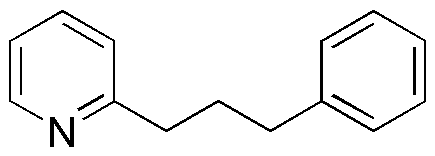2-(3-Phenylpropyl)pyridine is widely utilized in research focused on:
- Pharmaceutical Development: This compound serves as a key intermediate in synthesizing various pharmaceuticals, particularly those targeting neurological disorders, enhancing drug efficacy and specificity.
- Agrochemical Formulations: It is used in creating agrochemicals that improve crop yield and pest resistance, making it valuable for agricultural professionals seeking sustainable solutions.
- Material Science: The compound plays a role in developing advanced materials, such as polymers and coatings, which are essential in industries like automotive and electronics for their durability and performance.
- Research in Organic Chemistry: It is a valuable reagent for organic synthesis, helping researchers create complex molecules more efficiently, thus accelerating innovation in chemical research.
- Biochemical Applications: This chemical is explored for its potential in biochemical assays, aiding in the development of diagnostic tools and therapeutic agents in the medical field.
General Information
Properties
Safety and Regulations
Applications
2-(3-Phenylpropyl)pyridine is widely utilized in research focused on:
- Pharmaceutical Development: This compound serves as a key intermediate in synthesizing various pharmaceuticals, particularly those targeting neurological disorders, enhancing drug efficacy and specificity.
- Agrochemical Formulations: It is used in creating agrochemicals that improve crop yield and pest resistance, making it valuable for agricultural professionals seeking sustainable solutions.
- Material Science: The compound plays a role in developing advanced materials, such as polymers and coatings, which are essential in industries like automotive and electronics for their durability and performance.
- Research in Organic Chemistry: It is a valuable reagent for organic synthesis, helping researchers create complex molecules more efficiently, thus accelerating innovation in chemical research.
- Biochemical Applications: This chemical is explored for its potential in biochemical assays, aiding in the development of diagnostic tools and therapeutic agents in the medical field.
Documents
Safety Data Sheets (SDS)
The SDS provides comprehensive safety information on handling, storage, and disposal of the product.
Product Specification (PS)
The PS provides a comprehensive breakdown of the product’s properties, including chemical composition, physical state, purity, and storage requirements. It also details acceptable quality ranges and the product's intended applications.
Certificates of Analysis (COA)
Search for Certificates of Analysis (COA) by entering the products Lot Number. Lot and Batch Numbers can be found on a product’s label following the words ‘Lot’ or ‘Batch’.
*Catalog Number
*Lot Number
Certificates Of Origin (COO)
This COO confirms the country where the product was manufactured, and also details the materials and components used in it and whether it is derived from natural, synthetic, or other specific sources. This certificate may be required for customs, trade, and regulatory compliance.
*Catalog Number
*Lot Number
Safety Data Sheets (SDS)
The SDS provides comprehensive safety information on handling, storage, and disposal of the product.
DownloadProduct Specification (PS)
The PS provides a comprehensive breakdown of the product’s properties, including chemical composition, physical state, purity, and storage requirements. It also details acceptable quality ranges and the product's intended applications.
DownloadCertificates of Analysis (COA)
Search for Certificates of Analysis (COA) by entering the products Lot Number. Lot and Batch Numbers can be found on a product’s label following the words ‘Lot’ or ‘Batch’.
*Catalog Number
*Lot Number
Certificates Of Origin (COO)
This COO confirms the country where the product was manufactured, and also details the materials and components used in it and whether it is derived from natural, synthetic, or other specific sources. This certificate may be required for customs, trade, and regulatory compliance.

